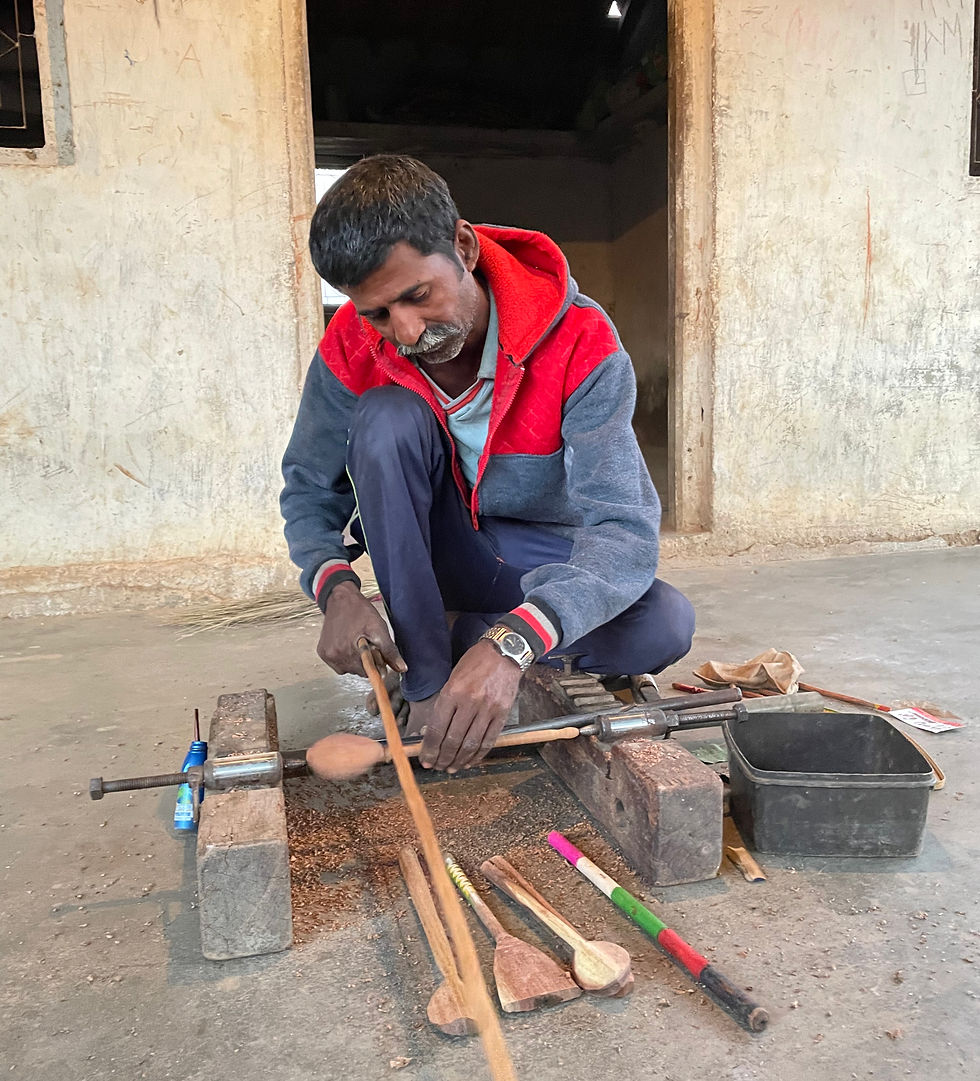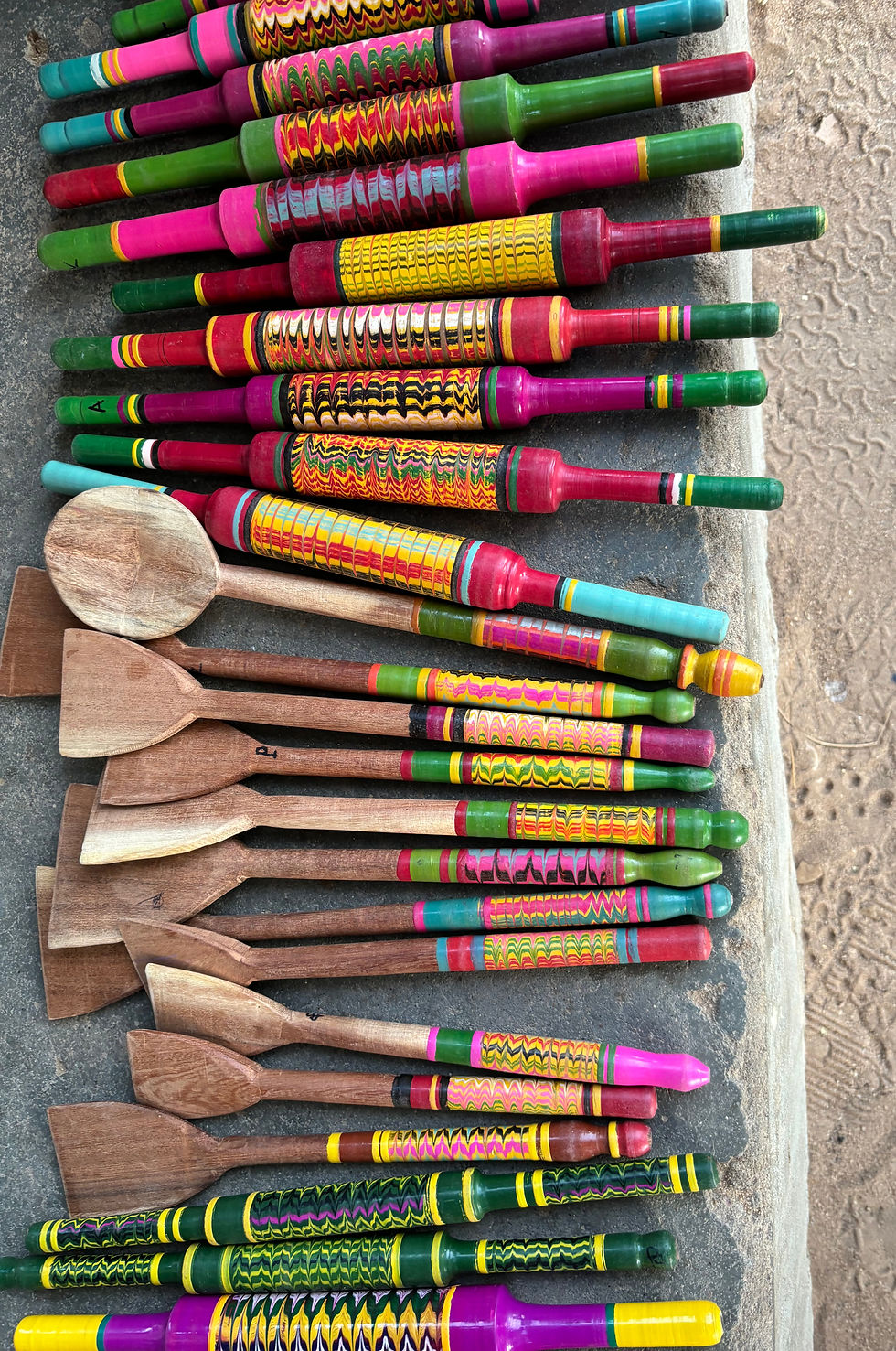Uncovered Stories - The Vadha Community of Nirona
- Siân Warren
- Feb 19
- 3 min read
January 2025, Nirona
In the heart of Kutch, Gujarat lies Nirona, a village brimming with artistic spirit and cultural vibrancy. Among its most unique inhabitants is the Vadha community, known for their colourful lacquerware utensils. This post explores the stories that I have learnt from my many years of visiting the community, examining their cultural heritage and the role lacquer plays in Indian culture.

The Vadha Community: A Historical Perspective
The Vadhas, a once-nomadic community, have played an important role in Gujarat’s rich craft heritage, especially in the Kutch region. Traditionally, they travelled through villages like Nirona and Jura, sourcing wood, natural stones, and pigments from the forests to create beautiful lacquerware. Their craftsmanship was deeply intertwined with the Maldhari community, with whom they bartered their handmade goods for essentials and services.
Today, many Vadha families have settled in Kutch permanently, with Nirona remaining a hub for their unique craft. However, with changing times and economic challenges, only a handful of families continue this tradition. For travellers seeking an authentic cultural experience, visiting these artisans offers a special opportunity to witness traditional lacquer art firsthand, connect with master craftsmen, and support a lesser known craft of the region.
The Art of Lacquerware
The process begins with an artisan crafting a wooden base, followed by layering it with lacquer. The coloured lacquer is applied to the wood using heat while spinning it on a hand lathe. During this process, the artisan skilfully manipulates the lacquer to form intricate patterns - including their iconic zig-zag design.
The community typically use basic tools to make their items, with just a handful of individuals making utensils on a regular basis within their home on the edge of Nirona village.

Cultural Significance of Lac in Indian Society
Lacquer has been pivotal in the Indian way of life for centuries, representing more than just aesthetic appeal. It has long been used as a natural dye for wool and silk, producing rich shades of red, brown, and orange, and is also found in non-toxic printing inks for food packaging. In the polish industry, lac wax enhances shoe and floor polishes, automobile coatings, and even cosmetics like lipsticks. Its influence extends to media, where it was historically used in gramophone records and photographic films, as well as in sealing, including official post office stamps. As a sustainable and self-renewing material, lac remains an integral part of India’s artistic, industrial, and cultural industries.
When it comes to crafts, lac brings colourful and intricate detail to a wide range of handmade products. From bright jewellery and traditional bangles to beautifully lacquered wooden toys, furniture, and utility items, this age-old technique can be found inside many homes across the country.
Lac itself is a unique, natural resin known for being non-toxic, odourless, and tasteless. It is produced by the tiny Kerria lacca Kerr insect, which thrives on host plants. The term "lac" is derived from Persian and Hindi words meaning "hundred thousand", perhaps a reference to the vast number of tiny insects needed to produce this natural resin.
Socio-economic challenges for the Vadha Community
The transition from a nomadic way of life to settled communities has brought both opportunities and challenges for the Vadha community. While tourism has become a crucial source of income, it also introduces uncertainty, making the artisans and the sale of their utensils heavily dependent on seasonal demand.
Despite its rich heritage and the remarkable craftsmanship of producing lacquerware items, this tradition remains largely overlooked, struggling to find a place in the mainstream commercial craft market. The community, living on the fringes of Nirona, face harsh socio-economic realities - poverty, limited access to education, and a lack of resources to promote their craft. Without wider recognition and sustained support, this beautiful art form risks fading into obscurity. The barriers these artisans face not only threaten their livelihoods but also endanger the survival of a cultural legacy that has been passed down through many Vadha families.
Currently, there are some excellent NGO's in Kutch who are supporting the community in stocking their items throughout the non-tourist months, as well as these NGO's and certain individuals offering other support through educational training and access to health services.





Comments